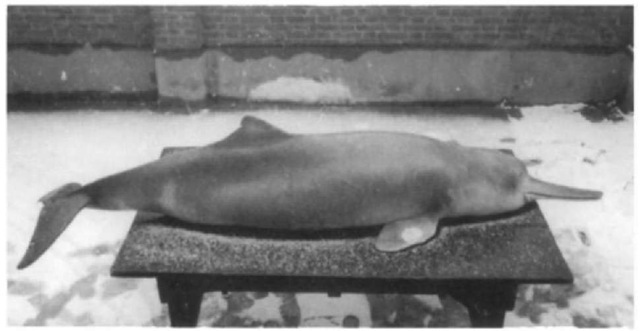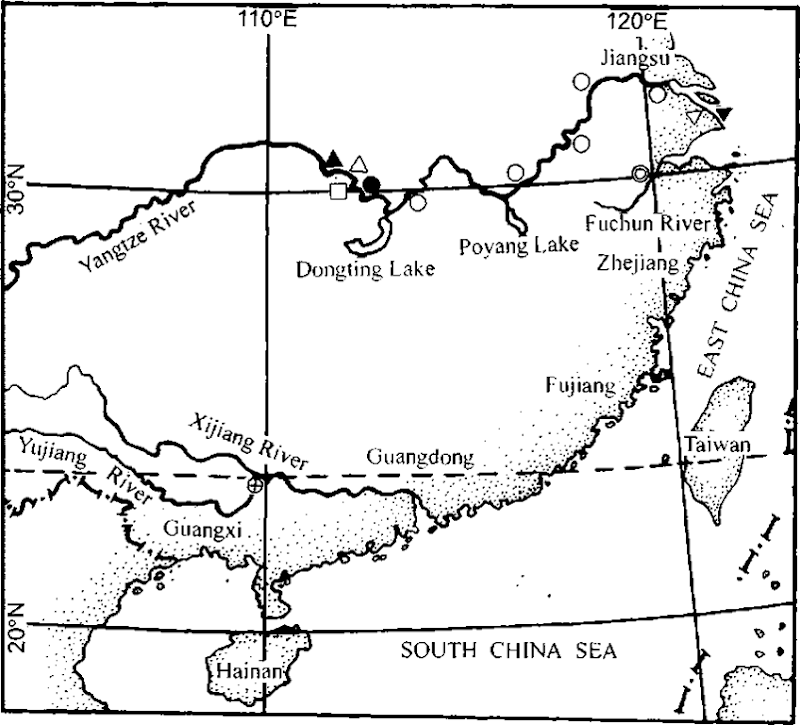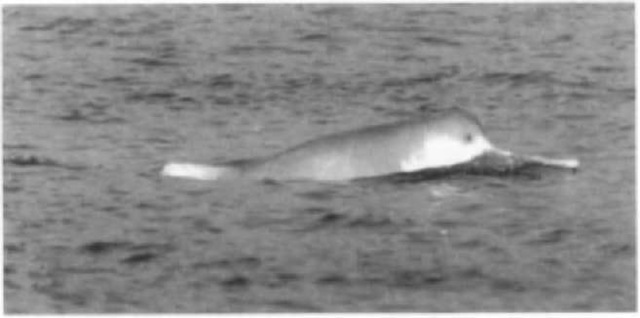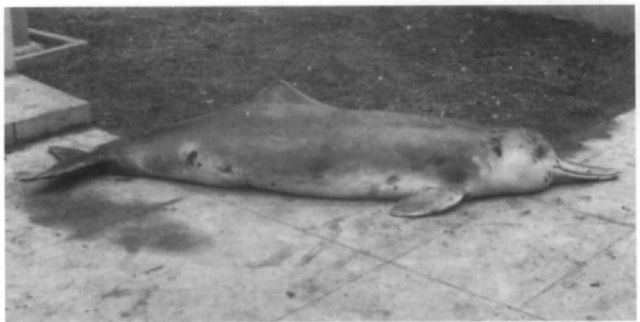The baiji, or Chinese river dolphin (Lipotes vexillifer), which inhabits the middle and lower reaches of the Yangtze River in China, is the rarest and most endangered cetacean in the world. Together with the vaquita in the eastern central Pacific, it is one of the two cetaceans classified as critically endangered in the 2000 IUCN red list of threatened species. In China, it is known by the name baiji, meaning white dolphin. The name dates from classical times and is to be found in die ancient dictionary, “Erh Ya,” published as long ago as 200 B.C. At that time, the Yangtze flowed clean and largely unencumbered from its source to the rich, sprawling Yangtze Delta, in the western Yellow Sea and East China Sea. The baiji has lived generation after generation and multiplied in number in the desirable environment of the Yangtze River for thousands of years. However, the population has declined in recent decades because of habitat degradation, accidental capture, and collisions with vessels. Recent information estimates a total population of only a few dozen animals.
I. Diagnostic Characters
The baiji is a graceful animal with a very long, narrow and slightly upturned beak. It can be easily identified by the rounded melon, longitudinally oval blowhole, very small eyes, low triangular dorsal fin, and broad rounded flippers (Fig. 1). The color is generally bluish gray or gray above and white or ashy-white below. Females are larger than males. The maximum recorded length for females is 253 cm and for males 229 cm (Zhou, 1989). Significant differences between the sexes in external proportions have been demonstrated in nine characters, and skull size is also sexually dimorphic (Gao and Zhou, 1992).
The Yangtze River is turbid. Visibility from the surface downward is about 25-35 cm in April and 12 cm in August. A corresponding regression has taken place in the eye of the baiji. The eyes are much smaller and placed much higher than those of other dolphins. However, they are functional, and objects on the surface or near the surface directly in front of the eye can be distinguished (Zhou, 1989).
II. Taxonomy
The species was classified previously as either in the family Platanistidae or Iniidae (Brownell and Herald, 1972). Zhou et al. (1978) established the new family Lipotidae for it based on osteological studies and anatomy of the stomach. Barnes (1985) recognized a fossil, Parapontoporia, as morphologically intermediate between Pontoporia and Lipotes and placed Lipotes and the fossil taxon each in a subfamily of Pontopori-idae. Conversely, de Muizon (1988) placed the fossil taxon with Lipotes in Lipotidae, and Rice (1998) following de Muizon ranked Lipotidae as a family. Studies of mitochondrial cytochrome b gene sequences indicate that the sequence difference between Lipotes and Pontoporia is similar to or greater than those among other odontocete families. Molecular evidence also supports ranking Lipotidae as a family rather than as a subfamily of Pontoporiidae (Yang and Zhou, 1999). The only fossil placed close to Lipotes is Prolipotes, based on a fragment of mandible with teeth of Tertiary age from China (Zhou et al, 1984). This indicates that the baiji is a relict species.
Figure 1 Carcass of a 2.45 m adult female baiji with a notch on dorsal fin; found drifting down river near Jiangyin on January 15, 1996.
III. Distribution
Baiji are found mainly in the mainstream of the middle and lower reaches of the Yangtze River, although individuals might occasionally enter some tributary lakes during intense flooding. Dongting Lake was originally incorrectly reported to be the only habitat. The presence of this dolphin in the Yangtze River is noted in documents going back about 2000 years. In the 1940s, the uppermost records in the Yangtze River were at Huanglingmiao and Liantuo in the Three Gorges area, approximately 50 km upstream of die Gezhouba Dam near Yichang (Zhou et al, 1977). Baiji could be found up to Yichang in the 1970s, which is about 1700 km up from the mouth of the river. However, the range was no further upstream than Zhicheng in the 1980s, and than Shashi in the 1990s; the latter is approximately 150 km downstream of the dam site. In the lower part of the river, specimens of the baiji were obtained in the Yangtze estuary, off the eastern end of Chongming Island, Shanghai, in the 1950s and 1960s. The range has been no further downstream than Liuhe since the 1970s (Fig. 2). Results of recent surveys of almost all the species’ previous range, Shanghai to Yichang, suggest that the population is very small and is still declining. Baiji were also seen in the Fuchun River during the great flood of 1955 but disappeared from that river after the construction of a hydropower station in 1957 (Zhou et al, 1977).
IV. Ecology
Baiji are generally found in eddy countercurrents below meanders and channel convergences. They live in small groups.
Figure 2 Map of China shotving distribtition of baiji, Lipotes vexillifer, and the fossil Prolipotes yujiangensis. Baiji, L. vexillifer: A, Huanglingmiao and Liantuo, the uppermost records in the 1940s; A, Yichang, the uppermost records in the 1970s; Zicheng, the uppermost records in the 1980s; Shashi, the upstream limit of dist ribution in the 1990s; O, distribution in the 1990s; Yangtze estua ry, the lowest records in the 1950s and 1960s; V, Liuhe, the downstream limit of distribution in the 1990s; and , Tonglu and Fuyang, records in the 1950s in the Fuchun River. P. yujiangenesis: . Guiping, locality where the fossil was found.
Figure 3 Free-ranging baiji in the Yangtze River near Tongling.
In the 1980s, the most common group size was 3 to 4 animals; the largest group observed was about 16 individuals in the middle reaches of the Yangtze River. These larger groups were probably temporary aggregations of several groups. The baiji usually surfaces without causing white water and breathes in a smooth manner (Fig. 3). It has a sequence of several short breathing intervals (10-30 sec) alternating with a longer one, the longest one up to 200 sec (Zhou et al., 1994). Photographic identifications and sighting records show that baiji groups make both local and long-range movements. The largest recorded range of a recognizable baiji was 200+ km from the initial sighting location (Zhou et al, 1998).
The baiji appears to take any available species of freshwater fish, the only selection criterion being size. The fish should not be so large that it cannot go down the throat. Sometimes, dead fish are seen floating on the Yangtze with patches of scales torn off. They are believed to have been prey of baiji. At times, a baiji may try a number of times to swallow a large fish, but in vain and finally letting go (Zhou and Zhang, 1991).
Body length at birth is estimated to be 91.5 cm for both males and females. The sexes have about the same growth rate until they are about 4 years old based on estimates of dentinal growth layer groups (GLGs), which is the age at sexual maturation for males. After sexual maturation, males grow more slowly than females. Females attain sexual maturation at about 6 years. They continue to grow until about age 8. The smallest mature male and female described were 180 and 200 cm long, respectively. The oldest animal that was age-determined was a 242 cm female of 24 years of age, and a 21-year-old male was estimated to be about 214 cin in body length (Gao and Zhou, 1992). The baiji probably breeds and gives birth in the first half of the year. The peak calving season appears to be February to April.
V. Threats
The Yangtze is suffering massive habitat degradation. The banks of the Yangtze have been modified extensively to prevent destructive flooding of agricultural areas, thus reducing the floodplain area. Construction of darns and other barriers along the river and its tributaries has led to changes in fish abundance and distribution. Wastewater volume discharged into the Yangtze is aboirt 15.6 billion cubic meters per year. Approximately 80% of the wastewaters are discharged directly into the environment without treatment.
The threats against the baiji include river traffic, fishing gear (Fig. 4), reduction of fishery resources, and water pollution (Chen and Hua, 1989; Zhou et al, 1998). Unfortunately, the major threats are continuing and appear to be rapidly becoming more serious. Although it is one of the nationally protected animals in China, the baiji population is reported to have declined from about 400 animals in 1979-1980, to 200 or so in 1986, to about 100 in 1989-1991, and to a few dozen in 1998. The species is facing a very high risk of extinction.
Figure 4 Baiji taken from the Yangtze River near Nanjing in 1982, with 103 hook scars and 5 ulcers on the skin.




